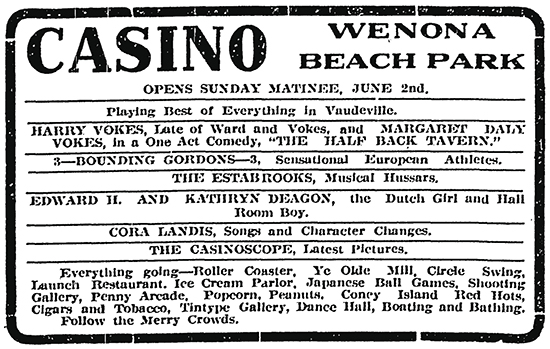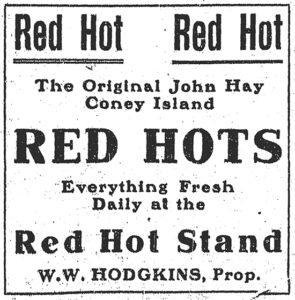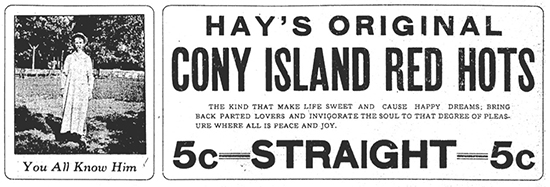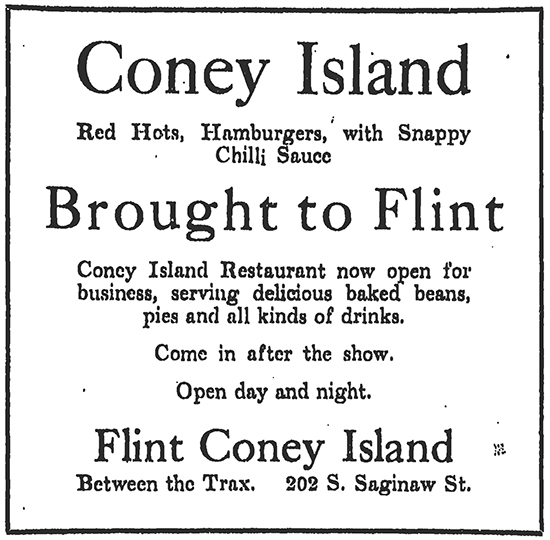
There is constant debate about when and where the Coney Island hot dog was first served. As to current discussions and, yes, arguments, the earliest known year is 1914, with Ft. Wayne’s Famous Coney Island Wiener Stand in Ft. Wayne, Indiana [“History page“, Ft. Wayne’s Famous Coney Island], and both Todoroff’s Original Coney Island in Jackson, Michigan [“Todoroff’s Original Coney Island“, Jackson, MI], and Virginia Coney Island [Virginia Coney Island, Jackson, Michigan] opening that year. Specific opening dates for those three locations are not known.
Considering these definitions, and in researching older newspapers, it’s now apparent the first Coney Islands weren’t where they might have been expected. The first decade of the twentieth century saw numerous Coney Island stands and shops opening across the country, “bringing Coney Island” to those communities. An example of this occuring in Michigan were a pair of Coney Island Red Hot stands operated by one individual, a John L. Hay, at waterside parks in Saginaw and Bay City.




Flint Coney Island's New York Red Hots

Coney Shops Opening Dates Nationwide
A timeline of openings of the first two decades of the earliest coney island restaurants in widespread areas of the US is rather telling. The first two, Mr. Hay’s stands, are included merely as examples of earlier Coney Islands, not as definitive “firsts.” It’s possible, albeit likely, that any claim of a “first” stand outside of New York City may never be proven.
- 1907 – Original John Hay Red Hot Coney Island Stand, Bay City, Michigan (closed 1920)
- 1911 – Hay’s Cony Island Red Hot Stand, Saginaw, Michigan (closed 1919)
- 1914 – Ft. Wayne Coney Island, Ft. Wayne, Indiana
- 1914 – Todoroff’s Coney Island, Jackson, Michigan (closed 2008)
- 1914 – Virginia Coney Island, Jackson, Michigan
- 1915 – Coney Island Kalamazoo, Kalamazoo, Michigan
- 1916 – Coney Island Lunch, McKeesport, Pennsylvania (closed 2017)
- 1917 – American Coney Island, Detroit, Michigan
- 1917 – The Coney Island Lunch Restaurant & Tavern, Pottsville, Pennsylvania
- 1918 – George’s Coney Island, Worcester, Massachusetts
- 1918 (?) – Lafayette Coney Island, Detroit, Michigan
(The story about the American and Lafayette coney shops can be found here.) - 1920 – Flint Coney Island, Flint, Michigan, serving New York Red Hots
- 1923 or 1924 – Flint Coney Island, Flint, Michigan, when the recipe changed from NY-style to Flint style; closed 1979
- 1920 – Nick’s Coney Island, Fall River, Massachusetts
- 1921 – Red Hot’s Coney Island, Highland Park, Michigan (closed 2021)
- 1921 – Original Coney Island, Duluth, Minnesota (closed 2017)
- 1922 – Empress Chili, Cincinnati, Ohio
(While not specifically termed a “coney island”, the Macedonion roots and culture are uniquely similar to other coney shops of the time.) - 1922 – Original Coney Island Sandwich Shop, Portland, Oregon (founded by Louis Gellos, closed 1969)
- 1923 – Coney Island Lunch, Scranton, Pennsylvania
- 1923 – Coney Island Texas Lunch, Scranton, Pennsylvania
- 1923 – James Coney Island, Houston, Texas
- 1923 – Mama Vicki’s Coney Island, Port Huron, Michigan
- 1923 – M&P Coney Island, New Castle, Pennsylvania
- 1926 – Coney Island Hot Weiners, Tulsa, Oklahoma
(Founder and Greek immigrant Christ Economou had opened Coney Island Lunch in McKeesport, Pennsylvania ten years earlier, which closed in 2017. Coney Island Hot Weiners in Tulsa was his 27th coney shop, and his first in Oklahoma.) - 1928 – Coney Island Deluxe, Duluth, Minnesota
Except for Lafayette and American Coney Islands in Detroit, Todoroff’s and Virginia Coney Island in Jackson, Michigan, and Coney Island Lunch and Coney Island Texas Lunch, both in Scranton, Pennsylvania, each of the owners would likely not have known what the others were doing, as communication between immigrants in those days was sparse. It’s also clear that the owners immigrated from various parts of Greece and Macedonia at various times. That the Coney Island phenomenon occured at all is an interesting matter.
